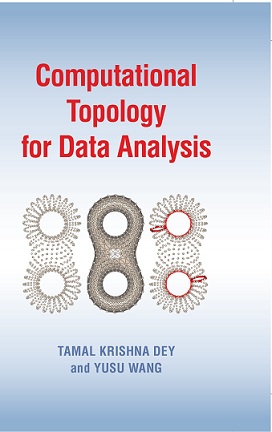
(published by Cambridge University Press)
Tamal K Dey
Department of Computer Science, Purdue University, IN
Yusu Wang
Halicioglu Data Science Institute, UC San Diego, CA
Copyright: Tamal Dey and Yusu Wang 2016-2021
Get an electronic copy
MAA review and zbMath review
Get an electronic copy
MAA review and zbMath review
Errata detected in the print are corrected in electronic version marked with red text
This material has been / will be published by Cambridge University Press as Computational Topology for Data Analysis by Tamal Dey and Yusu Wang. This pre-publication version is free to view and download for personal use only. Not for re-distribution, re-sale, or use in derivative works.

- Contents
| Chapter 1: Basic Topology |
a. Topological spaces, metric space topology |
| b. Maps: homeomorphisms, homotopy equivalence, isotopy |
|
| c. Manifolds d. Functions on smooth manifolds e. Notes and Exercises |
|
| Chapter 2 (i) . Complexes |
a. Simplicial complexes b. Nerves, Cech and Vietoris-Rips complexes c. Sparse complexes (Delaunay, Alpha, Witness) d. Graph induced complexes e. Notes and Exercises |
| Chapter 2 (ii). Homology |
a. Chains, cycles, boundaries, homology groups, Betti numbers b. Induced maps among homology groups c. Relative homology groups d. Singular homology groups e. Cohomology groups f. Notes and Exercises |
| Chapter 3. Topological persistence |
a. Filtrations, Persistent homology b. Persistence diagram c. Bottleneck distance and its computation d. Persistence algorithm, matrix reduction, clearing, cohomology algorithm e. Persistence modules f. Persistence for PL-functions g. Notes and Exercises |
| Chapter 4. General Persistence (Zigzag) |
a. Towers, Persistence modules from simplicial maps b. Algorithm for towers with annotations c. Zigzag persistence and algorithms d. Level Set persistence e. Extended persistence f. Notes and Exercises |
| Chapter 5. Generators and Optimality |
a. Greedy algorithm for optimal (H_1)-basis b. Computing optimal cycle in a given class d. Computing optimal persistent cycles e. Notes and Exercises |
| Chapter 6. Topological analysis of point clouds |
a. Rips and Cech filtrations on PCD b. Sparsified Rips filtrations c. Homology inference from PCD d. Homology inference for scalar fields e. Notes and Exercises |
| Chapter 7. Reeb graphs |
a. Reeb graphs: Definitions and properties b. Algorithms in the PL-setting c. Homology groups for Reeb graphs d. Distances for Reeb graphs e. Notes and Exercises |
| Chapter 8. Topological analysis of graphs |
a. Topological summaries for graphs b. Graph comparisons c. Topological invariants for directed graphs d. Computing persistent path homology e. Notes and Exercises |
| Chapter 9. Nerve, Cover, Mapper |
a. Cover and Nerve b. Persistent H_1-classes c. Mapper and multiscale mapper d. Stability of (multiscale) mapper e. Approximating multiscale mapper f. Notes and Exercises |
| Chapter 10. Discrete Morse Theory and Applications | a. Discrete Morse function b. Discrete Morse Vector Field (DMVF) c. Persistence Based DMVF d. Stable and unstable manifolds e. Graph reconstruction using DMVF f. Application to road network and neuronal reconstrcution g. Notes and Exercises |
| Chapter 11. Multiparameter persistence and decomposition |
a. Multiparameter persistence modules b. Presentation c. Presentation matrix: simplification and diagonalization d. Total diagonalization algorithm e. Computing presentations f. Invariants g. Notes and Exercises |
| Chapter 12. Multiparameter persistence and distances |
a. Persistence modules from categorial viewpoint b. Interleaving distance c. Matching distance and its computation d. Bottleneck distance and its computation e. Notes and Exercises |
| Chapter 13. Topological persistence and Machine learning |
a. Feature vectorization of persistence diagrams b. Optimizing topological loss function c. Statistical treatment of topological summaries d. Notes and Exercises |
- For errata, please communicate to tamaldey@purdue.edu and yusuwang@ucsd.edu